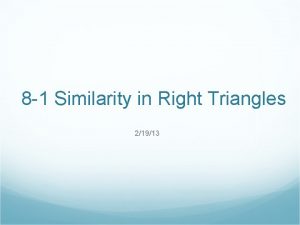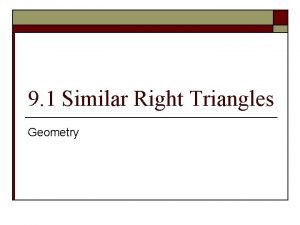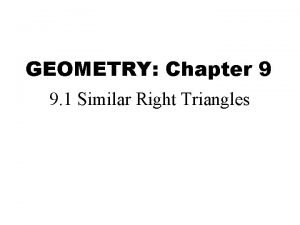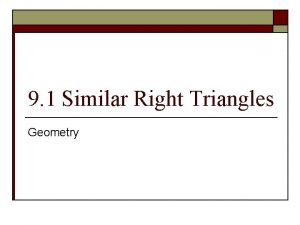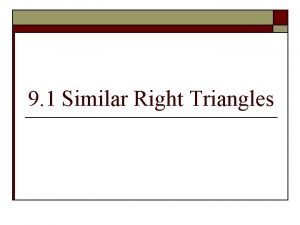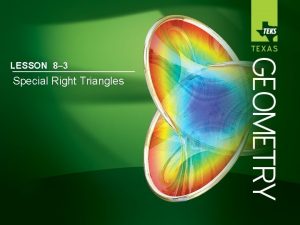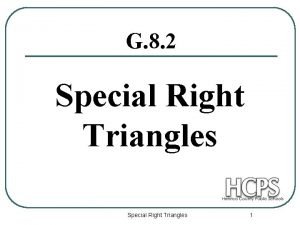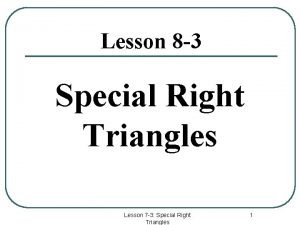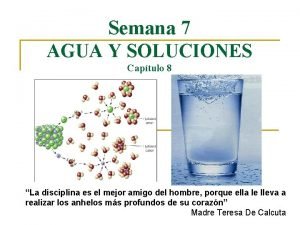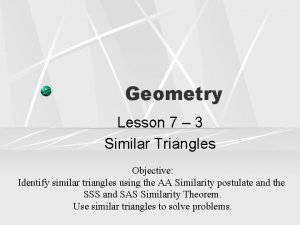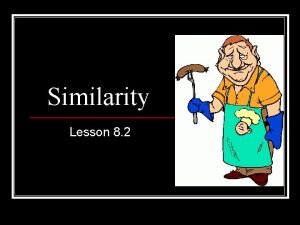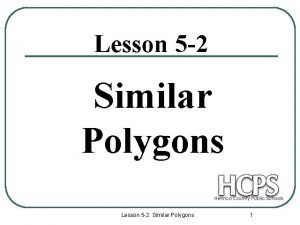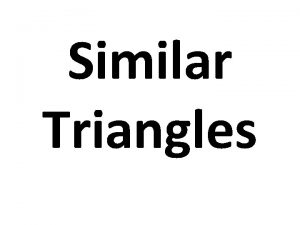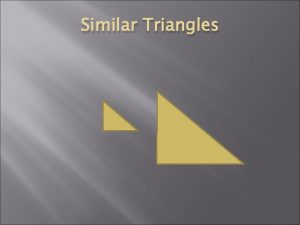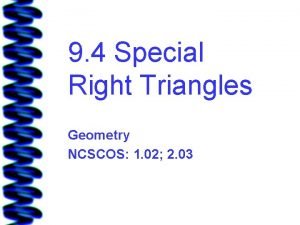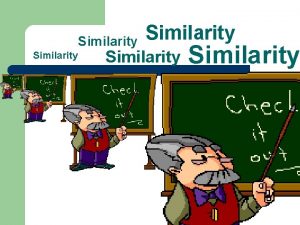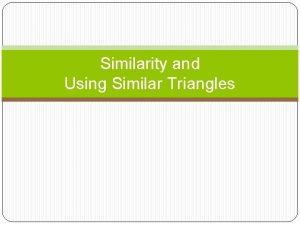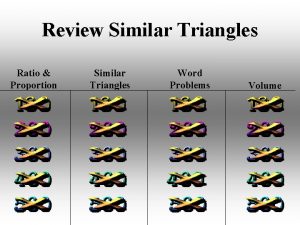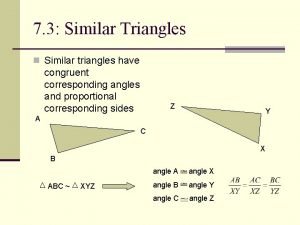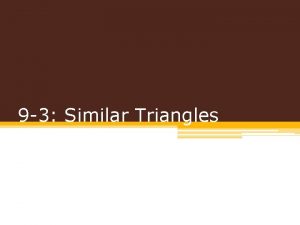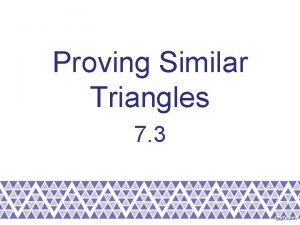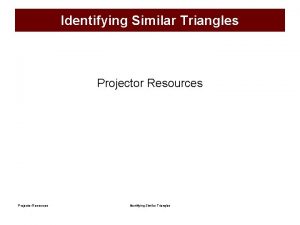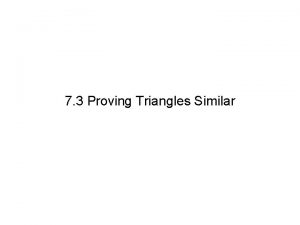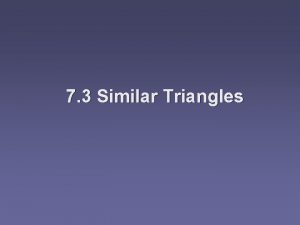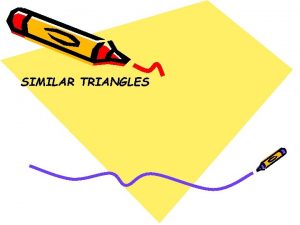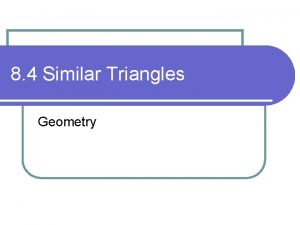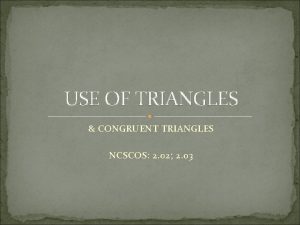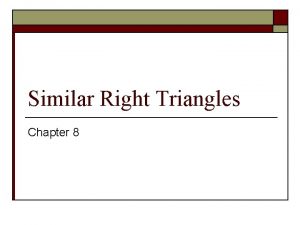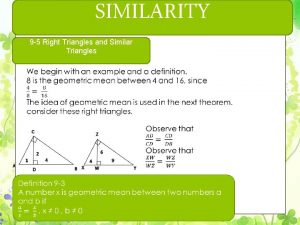9 1 Similar Right Triangles Geometry NCSCOS 1




















- Slides: 20

9. 1 Similar Right Triangles Geometry NCSCOS: 1. 02; 2. 03

Standard 1. 02 & 2. 03: 1: The learner will perform operations with real numbers to solve problems 2 : The learner will use geometric and algebraic properties to solve problems and write proofs.

E. Q: o How do we solve problems involving similar right triangles and geometric mean? Vocabulary: Altitude, indirect measurements o

Key Learning o o Solve problems involving similar right triangles formed by the altitude drawn to the hypotenuse of a right triangle. Use a geometric mean to solve problems such as estimating a climbing distance.

Proportions in right triangles o In Lesson 8. 4, you learned that two triangles are similar if two of their corresponding angles are congruent. For example ∆PQR ~ ∆STU. Recall that the corresponding side lengths of similar triangles are in proportion.

Activity: Investigating similar right triangles. Do in pairs or threes 1. 2. 3. 4. Cut an index card along one of its diagonals. On one of the right triangles, draw an altitude from the right angle to the hypotenuse. Cut along the altitude to form two right triangles. You should now have three right triangles. Compare the triangles. What special property do they share? Explain. Tape your group’s triangles to a piece of paper.

What did you discover? o In the activity, you may have discovered the next theorem. A plan for proving theorem appears on page 528. You are asked to prove theorem in Exercise 34 on page 533.

Theorem 9. 1 o If the altitude is drawn to the hypotenuse of a right triangle, then the two triangles formed are similar to the original triangle and to each other. ∆CBD ~ ∆ABC, ∆ACD ~ ∆ABC, ∆CBD ~ ∆ACD

A plan for proving thm. 9. 1 is shown below: o o o Given: ∆ABC is a right triangle; altitude CD is drawn to hypotenuse AB. Prove: ∆CBD ~ ∆ABC, ∆ACD ~ ∆ABC, ∆CBD ~ ∆ACD Plan for proof: First prove that ∆CBD ~ ∆ABC. Each triangle has a right angle and each includes B. The triangles are similar by the AA Similarity Postulate. You can use similar reasoning to show that ∆ACD ~ ∆ABC. To show that ∆CBD ~ ∆ACD, begin by showing that ACD B because they are both complementary to DCB. Then you can use the AA Similarity Postulate.

Ex. 1: Finding the Height of a Roof o o o Roof Height. A roof has a cross section that is a right angle. The diagram shows the approximate dimensions of this cross section. A. Identify the similar triangles. B. Find the height h of the roof.

Solution: o You may find it helpful to sketch the three similar triangles so that the corresponding angles and sides have the same orientation. Mark the congruent angles. Notice that some sides appear in more than one triangle. For instance XY is the hypotenuse in ∆XYW and the shorter leg in ∆XZY. ∆XYW ~ ∆YZW ~ ∆XZY.

Solution for b. o Use the fact that ∆XYW ~ ∆XZY to write a proportion. YW ZY = XY XZ Corresponding side lengths are in proportion. h 5. 5 = 3. 1 6. 3 Substitute values. 6. 3 h = 5. 5(3. 1) h ≈ 2. 7 Cross Product property Solve for unknown h. The height of the roof is about 2. 7 meters.

Using a geometric mean to solve problems o In right ∆ABC, altitude CD is drawn to the hypotenuse, forming two smaller right triangles that are similar to ∆ABC From Theorem 9. 1, you know that ∆CBD ~ ∆ACD ~ ∆ABC.

Write this down! Notice that CD is the longer leg of ∆CBD and the shorter leg of ∆ACD. When you write a proportion comparing the legs lengths of ∆CBD and ∆ACD, you can see that CD is the geometric mean of BD and AD. Longer leg of ∆CBD. Shorter leg of ∆CBD. BD CD Shorter leg of ∆ACD = CD AD Longer leg of ∆ACD.

Copy this down! Sides CB and AC also appear in more than one triangle. Their side lengths are also geometric means, as shown by the proportions below: Shorter leg of ∆ABC. Hypotenuse of ∆ABC. BD CD Hypotenuse of ∆CBD = CD AD Shorter leg of ∆CBD.

Copy this down! Sides CB and AC also appear in more than one triangle. Their side lengths are also geometric means, as shown by the proportions below: Longer leg of ∆ABC. Hypotenuse of ∆ABC. BD CD Hypotenuse of ∆ACD = CD AD Longer leg of ∆ACD.

Geometric Mean Theorems o o Theorem 9. 2: In a right triangle, the altitude from the right angle to the hypotenuse divides the hypotenuse into two segments. The length of the altitude is the geometric mean of the lengths of the two segments Theorem 9. 3: In a right triangle, the altitude from the right angle to the hypotenuse divides the hypotenuse into two segments. The length of each leg of the right triangle is the geometric mean of the lengths of the hypotenuse and the segment of the hypotenuse that is adjacent to the leg. BD CD = CD AD AB CB = CB DB AB AC = AC AD

What does that mean? 6 x √ 9 ∙ √ 2 = x 5+2 = y 7 = y 14 = y 2 3 √ 2 = x √ 14 = y = 18 = x 2 √ 18 = x x 3 y 2

Ex. 3: Using Indirect Measurement. o MONORAIL TRACK. To estimate the height of a monorail track, your friend holds a cardboard square at eye level. Your friend lines up the top edge of the square with the track and the bottom edge with the ground. You measure the distance from the ground to your friend’s eye and the distance from your friend to the track.

In the diagram, XY = h – 5. 75 is the difference between the track height h and your friend’s eye level. Use Theorem 9. 2 to write a proportion involving XY. Then you can solve for h.
 Family time
Family time Right product right place right time right price
Right product right place right time right price Right triangle similarity theorem
Right triangle similarity theorem Similar right triangles
Similar right triangles Geometric mean altitude theorem
Geometric mean altitude theorem Copy this
Copy this Similar right triangles
Similar right triangles δqrs is a right triangle.
δqrs is a right triangle. How to solve special right triangles
How to solve special right triangles Geometry 8-3 special right triangles
Geometry 8-3 special right triangles Ncscos
Ncscos Ncscos
Ncscos Ncscos
Ncscos The right man on the right place at the right time
The right man on the right place at the right time Precipitancy creates prodigality
Precipitancy creates prodigality Similar disuelve a similar
Similar disuelve a similar Similar disuelve a similar
Similar disuelve a similar Similar disuelve a similar
Similar disuelve a similar Lesson 7-3 similar triangles answers
Lesson 7-3 similar triangles answers Similar polygons definition geometry
Similar polygons definition geometry Similar polygons definition
Similar polygons definition


